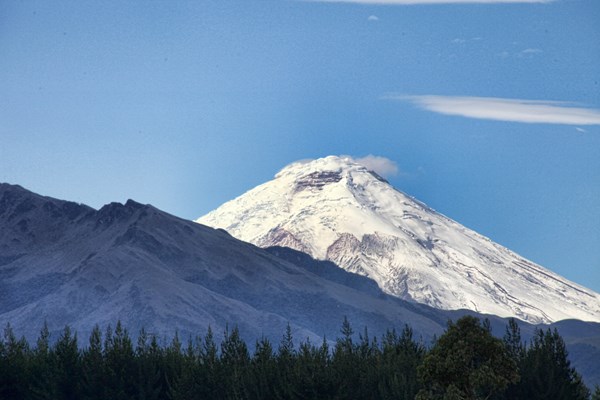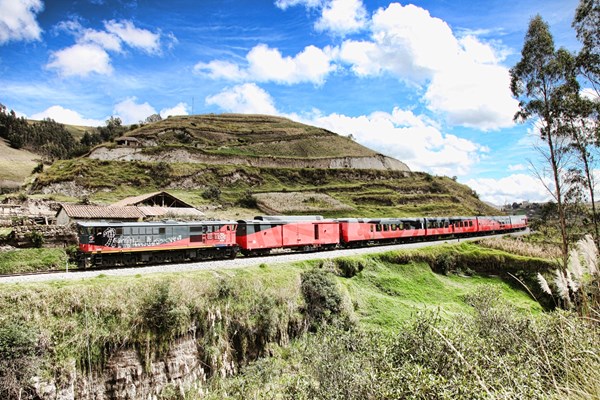QUITO, ECUADOR, Aug. 14, 2013 (GLOBE NEWSWIRE) -- Posicionarte, a travel & pr media agency, was invited to discover the brand new Ecuador's cruise train trip 4 days 3 nights from the Andes to Coast, it's travel editor Andrew Taylor, takes a "train-cruise" through the Avenue of Volcanoes in the Ecuadorian Andes.
"I feel like I am entering an Agatha Christie novel at Chimbacalle station in Quito" Andrew tells us. "I am handed nibbles on silver trays and feel I should cross my knees, perhaps twiddle my moustache somewhat and ponder the next explosion." The restored train line from Quito and Guayaquil is an icon of immense pride in Ecuadorian culture.
It brought together coast and highland through a trip that previously (by mule) would have taken three weeks, if indeed you survived it. Recently restored as a tourist excursion train, it offers an epic (educational) journey incorporating indigenous highland market, a rose plantation, exquisite accommodation in grand haciendas and a visit to a Shuar Community, the nation famous for head-shrinking! The line slides through the enchanting Andes, paramos and nevadas, patch-worked fields, rivers, pastures and villages - a world where each province is named after their very own volcano.
Illinizas (5248m and 5126m)
We catch sight of the impressive Ilinizas from the inside of this first-class train with lounges, a bar, dining wagons and a delightful open terrace on the back. They are "twin" mountains, separated by a plateau of about a kilometre wide and used by climbers as acclimatization mountains for the giddy heights of volcanoes to come.
Cotopaxi (5897m)
We visit Limpiopungo glacial lake at the base of this majestic conical active volcano that is only 28km from Ecuador´s capital city of Quito. Cotopaxi is active, and while it has only erupted 50 times in the last 300 years, a large eruption would destroy much of the southern suburbs of Quito where 2 million people live.
The name Coto-paxi comes from the Kichwa word for neck and (strangely) the Mayan word for moon. The neck of the moon phenomena happens every 25 years on New Year´s Eve. From a pre-Incan altar at Callo the moon appears to sit on the volcanoes crater and this momentary symbiosis was a divinity to the Panzaleo people. We lunch at Callo at the stunning Hacienda of San Agustín, built around an Incan chapel, where llama come running into the courtyard for a feed.
The volcano is commonly featured in folk art (tigua) and its melting glacier forms streams that in turn feed rivers that feed the Amazon. The glacial recession is difficult to ignore.
Carihuairazo (5020m)
This volcano is dormant and means something like The Man of Ice and Snow. Ironically, Mount Carihuairazo glacier has lost most of its mass in the last decade and is predicted to disappear between 2020 and 2030. It forms part of the huge highland nature reserve of Chimborazo province, a protected ecosystem preserving camelids, llama and alpaca. Carihuairazo can be climbed year round, but sufficient height acclimatisation is needed. We pass it sipping hot chocolate on a sofa in our new, elegant mobile-home on tracks.
Tungurahua (5029m)
Tungurahua, the "throat of fire" is not only active, it is currently eruptive! It smokes by day and at night you can watch the crater spit and lava streams dribbling and glowing like gigantic embers in a breeze. When it rains it explodes with thunderous force. Its last dramatic eruption in 2006 killed five people and in 1999 a major ash fall required temporary evacuation of over 25,000 people nearby.
At its feet is a delightful spa town, Baños de Agua Santa where you can tenderise your stiff muscles in thermal spring pools and then stand under a waterfall (at full force) freezing into a state of pleasure/pain euphoria. On its other side are Ambato and Riobamba, worth stopping here for a week or two and check out Sangay National Park, camp at the Lagunas de Atillo, a temperate hide-away between the Highlands and Amazonia.
El Altar (5319m)
The dormant El Altar intrigues me. It has nine major peaks that form a horse-shoe ridge with a central basin and crater lake at around 4,200m. It´s a demanding climb best tried between December and February. A bus from Riobamba takes you to the ranger´s station where you walk in deep mud (between 4 to 6 hours) to a refuge with beds, hot water and a kitchen. The hike to the lake crosses a valley and then a very steep hill.
Chimborazo (6310m)
Once believed to be the highest mountain in the world, it maintains a couple of superlatives. It's the highest mountain in Ecuador (featured on the National Flag) and the mountain furthest from Earth's core (rather than sea level.) Indeed, it was with the help of this volcano and a Prussian explorer called Friedrich Alexander von Humboldt that we have our current understanding of the magnetic fields between the North and South poles. The province that surrounds it is largely a National Park where 60% of its inhabitants are indigenous. Here we meet a man of 79, Balthazar Uscha Tenesaca, "the last hielero of Chimborazo" who has spent his life climbing the volcano with his donkey to mine glacial ice. Once a formidable industry, before refrigeration, this ice allowed food to be stored and dispatched and (with the help of the train line) expanded the diets of thousands of highlanders (now able to taste seafood and coastal fruits.)
Balthazar is a modest national hero, and explains how once the glacier was very near his village but over the years it took a longer and longer climb. Now it takes eight hours to ascend and descend and he gets $10 for his load, sold at a local market. Balthazar still climbs twice a week, sometimes accompanied by his daughter who prays.
The Tren Crucero, scenic train ride in Ecuador Andes, experience is a gentle four days of genuinely friendly hospitality. (2013 Introductory Price is $990 all inclusive.)
Photos accompanying this release are available at:
http://www.globenewswire.com/newsroom/prs/?pkgid=20495
http://www.globenewswire.com/newsroom/prs/?pkgid=20496
CONTACT:Jorge Alvarado
jalvarado@posicionarte.net
59-3-222-48134
www.posicionarte.net

